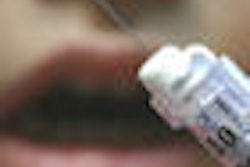
If you twist your ankle or bump your head, you apply ice to numb the pain. And parents have long frozen their babies' teething rings. So why not try the same approach before an injection? That's the thinking behind a refrigerant recently tested as an alternative to topical anesthesia.
In a study published in the January issue of the Journal of the American Dental Association (Vol. 140:1, pp 68-72), U.S. Air Force researchers found that applying 1,1,1,3,3-pentafluoropropane/1,1,1,2-tetrafluoroethane (Pain Ease, Gebauer) on the palates of dental patients reduced the pain of injections more effectively than 20% benzocaine gel.
A refrigerant offers advantages over a topical anesthetic, said Amar Kosaraju, D.M.D., M.S.Ed., the deputy program director of the general dentistry residency at Bolling Air Force Base. "Topical anesthetic can get all over the place; sometimes it goes down the throat and patients don't like the taste."
The notion of chilling a dental injection site isn't completely novel, he noted. Other researchers have tried dichlorodifluoromethane or even ice frozen on a stick, and there are anecdotal reports of 1,1,1,2-tetrafluoroethane (Endo-Ice, Hygenic) being used.
But the FDA approved Pain Ease for oral use in 2004 on the basis of animal experiments, raising the possibility it might be useful in dentistry. Gebauer hasn't marketed it for that purpose. Rather, the company has promoted it for intramuscular and subcutaneous injections, IV starts, venipuncture, and minor surgical procedures such as foreign body removal or suturing.
That left Dr. Kosaraju and his colleague, Kraig Vandewalle, D.D.S., M.S., who directs residency research, to see how well it might work on dental patients. For the study, Dr. Kosaraju recruited 16 patients who were either undergoing full-mouth scaling and planing or needed restorations on both sides of the mouth.
He tossed a coin to decide which side of each patient's posterior palate to treat with Pain Ease and which side to treat with benzocaine before an injection of 0.3 mL (6 mg) of 2% lidocaine with 1:100,000 epinephrine. Of the 16 patients, 9 received the refrigerant first and 7 got the benzocaine first.
Dr. Kosaraju asked the patients to indicate their level of pain after the injection by marking a 100-mm line where 0 equaled "no pain" and 100 equaled "worst possible pain." The Pain Ease patients gave their pain a mean score of 17.7 ± 15.3. By contrast, they scored their pain with benzocaine at 26.2 ± 18.0. The difference was statistically significant (p = 0.1).
The refrigerant acts very quickly, Dr. Kosaraju said -- within 10 seconds compared to at least two minutes for topical anesthetic. It works by evaporating in the air, an action that takes energy from molecules in the skin, quickly lowering the skin temperature. In fact, the manufacturer warns that its use on diabetics "or persons with poor circulation" can cause frostbite.
"You can see the tissue blanch," Dr. Kosaraju said. "As soon as you see that, you know it's working."
In the animal experiments, the substance was found to be nontoxic when inhaled and unlikely to cause irritation to the mucosa, he reported.
Pain Ease comes in a spray bottle, which is awkward to use in the mouth, but Dr. Kosaraju got around the problem by spraying it into a medicine cup, then dabbing it on with a cotton-tipped applicator.
Still, he doesn't recommend that dentists rush out and buy Pain Ease just yet. "I personally think more research needs to be done," he said. In particular, he'd like to see studies done with more patients for greater statistical power.
Paul Moore, D.M.D., Ph.D., M.P.H., the chair of dental anesthesiology at the University of Pittsburgh and a consultant for some anesthetic companies, agreed. "It was not a very good study," he said.
Not only should the study have been larger, it should have been double-blinded and placebo-controlled, he said.
But Dr. Kosaraju questioned how a placebo could be devised since patients can easily detect whether or not the substance being applied is cold.



















